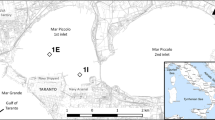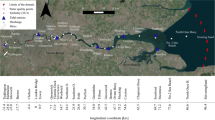Abstract
Experimental data collected by means of benthic chambers have been used to develop simple mathematical models in order to predict heavy metal and non-metal fluxes at the sediment-water interface. In particular, two mathematical models have been applied to Ba, Co, Fe, Pb, Mn and Cu.
Both models estimate benthic fluxes by means of Fick's law but they differ in the modelling of partition between liquid and solid phases. The first model, which is appropriate for Ba and Co, assumes that sorption is the most important process in determining partition. The second model, which gives discrete results for Fe and Pb, assumes that precipitation is the most important process determining the time variation of concentrations. Neither model is suitable to explain experimental data for Mn and Cu.
This paper demonstrates the benefit of the use of mathematical models in the interpretation of benthic chambers experiments and in the identification of the relevant processes occurring at the sediment-water interface.
Similar content being viewed by others
References
Adler, D. M., M. Admurer & P. H. Santschi, 1980. Metal tracers in two marine microcosms. sensitivity to scale and configuration. In J. P. Jr. Giesy (ed.), Microcosms in Ecological Research, D.O.E. Symposium Series 52. 349–368.
Adler, D. M., 1982. Tracers studies in marine microcosms: transport processes near the sediment-water interface. PhD Thesis, Columbia University.
Aller, R. C., 1977. The influence of macrobenthos on chemical diagenesis of marine sediments. Ph.D. Thesis, Yale Univ., New Haven.
Aller, R. C., 1980. Diagenetic processes near the sediment-water interface of Long Island Sound, l. Decomposition and nutrient element geochemistry (S, N, P). In B. Saltzman Estuarine Physics and Chemistry. Studies in Long Island Sound, Adv. Geophysics 22: 237–350.
Barbanti, A., V. U. Ceccherelli, F. Frascari, G. Reggiani & G. Rosso, 1992. Nutrient regeneration processes in bottom sediments in a Po delta lagoon (Italy), and the role of bioturbation in determining the fluxes at the sediment-water interface. Hydrobiologia 228: 1–21.
Bemer, R. A., 1980. Early diagenesis — A theoretical approach. Princeton Univ. Press, Princeton, 241 pp.
Ciceri, G. & W. Martinotti, 1988. Fast and accurate determination of sediments dry density and porosity, Envir. Technol. Lett. 9: 135–142.
Ciceri, G., S. Maran, W. Martinotti & G. Queirazza, 1992. Geochemical cycling of heavy metals in a marine coastal area: benthic flux determination from pore water profiles and in situ measurements using benthic chambers, Hydrobiologia 235/236: 501–517.
Corredor J. E. & J. M. Morrel, 1989. Assessment of inorganic nitrogen fluxes across the sediment-water interface in a tropical lagoon. Estuar. Coast. Shelf Sci. 28: 339–345.
Felmy, A. R., D. C. Girvin & E. A. Jenne, 1984. MINTEQ: a computer program for calculating aqueous geochemical equilibria. EPA-600/3-84-032, NTIS PB84-157148, Springfield, Virginia.
Hall, P. O. J, L. G. Anderson, A. Iverfeldt, M. M. Rutgers van der Loeff, B. Sundby & S. F. G. Westerlund, 1984. An in situ technique to measure chemical fluxes across the sediment-water interface under oxygenated and anoxic conditions. In P. Sly, Interaction between sediments and water 3, CEP Consultants, Ltd., Edinburgh.
Jahnke, R. A. & M. B. Christiansen, 1989. A free-vehicle benthic chamber instrument for sea floor studies. Deep Sea Res. 36: 625–637.
Li Y.-H. & S. Gregory, 1974. Diffusion of ions in sea water and in deep-sea sediments, Geochim. Cosmochim. Acta 38: 703–714.
Nyffeler, U. P., Y.-H. Li & P. H. Santschi, 1984. A kinetic approach to describe trace-element distribution between particles and solution in natural aquatic systems. Geochim. Cosmochim. Acta 48: 1513–1522.
Queirazza G., L. Guzzi, G. Ciceri & P. Frigieri, 1987. Environmental studies at the pre-operational and operational stages of nuclear power plant in Italy. Sci. total Envir. 64: 191–209.
Santschi, P. H., D. Adler, M. Amdurer, Y.-H. Li & J. J. Bell, 1980. Thorium isotopes as analogues for ‘particle reactive’ pollutants in coastal marine environments. Earth Planet. Sci. Lett. 24: 453–462.
Ulman, W. J., & R. C. Aller, 1982. Diffusion coefficients in nearshore marine sediments. Limnol. Oceanogr. 27: 352.
Vanderborght, J. P., Wollast, R. & Billen, G., 1977. Kinetic models of diagenesis in disturbed sediments. Part I. Mass transfer properties and silica diagenesis. Limnol. Oceanogr. 22: 787–793.
Author information
Authors and Affiliations
Rights and permissions
About this article
Cite this article
Maran, S., Ciceri, G. & Martinotti, W. Mathematical models for estimating fluxes at the sediment-water interface in benthic chamber experiments. Hydrobiologia 297, 67–74 (1995). https://doi.org/10.1007/BF00033503
Received:
Revised:
Accepted:
Issue Date:
DOI: https://doi.org/10.1007/BF00033503




